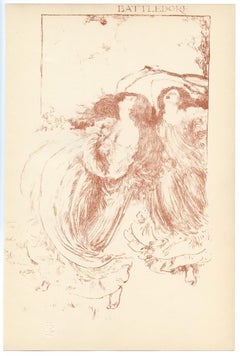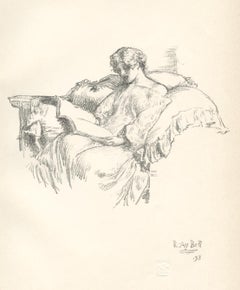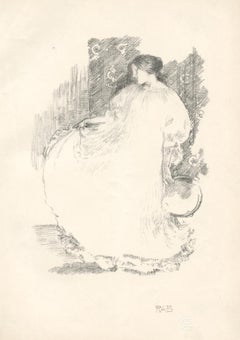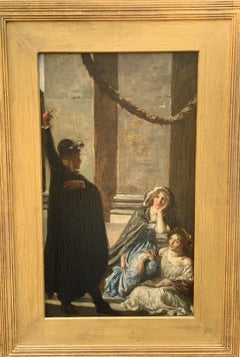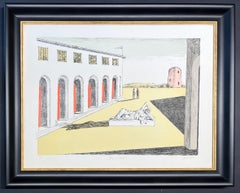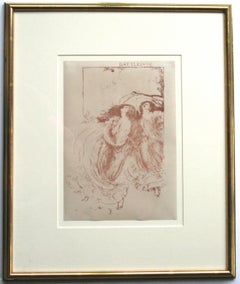Robert Anning Bell Art
British, 1863-1933
Born in London, Robert Anning Bell was trained as a painter at the Royal Academy Schools in 1881 and afterward at the Westminster School of Art. He later worked under Aimé Morot in Paris. George Frampton, whom Anning Bell worked under in London, became the leader of the Craft of Sculptors and The Art Workers Guild in 1884. He was largely responsible for encouraging artists to expand the variety of their materials and techniques. Anning Bell became a master of the Art Worker's Guild and, in addition to his paintings, made polychrome plaster relief images in the Arts and Crafts style.
It was Robert Anning Bell who designed mosaics for the Houses of Parliament and also Westminster Cathedral. to
2
3
1
1
Overall Width
to
Overall Height
to
3
2
1
5
4
3
2
2
1
1
3
2
1
1
6
8,230
2,807
1,651
1,318
2
4
1
Artist: Robert Anning Bell
"Battledore" original lithograph
By Robert Anning Bell
Located in Henderson, NV
Medium: original lithograph. Published in London in 1896 by The Studio. This delightful composition in sanguine ink on wove paper measures 11 1/8 x 7 1/2 inches (sheet size) -- 283 x 190 mm. Signed by Robert Anning Bell...
Category
1890s Robert Anning Bell Art
Materials
Lithograph
"The Music Score" original lithograph
By Robert Anning Bell
Located in Henderson, NV
Medium: original lithograph. Published in London in 1898 by The Studio. This delightful lithograph on wove paper measures 11 x 7 3/4 inches (sheet size). Signed by Robert Anning Bell...
Category
1890s Robert Anning Bell Art
Materials
Lithograph
"Study in Movement" original lithograph
By Robert Anning Bell
Located in Henderson, NV
Medium: original lithograph. Published in London in 1898 by The Studio. This beautiful lithograph on wove paper measures 11 x 7 3/4 inches (sheet size). Signed by Robert Anning Bell...
Category
1890s Robert Anning Bell Art
Materials
Lithograph
Victorian 19th century arts and crafts figure scene from a Shakespeare play
By Robert Anning Bell
Located in Woodbury, CT
Victorian 19th-century arts and crafts figure scene from a Shakespeare play
Robert Anning Bell was born on 14 April 1863 and educated at University College School in London. At the age of fifteen, he was articled for two years to an architect uncle before studying at the Royal Academy Schools, the Westminster School of Art (under Fred Brown), in Paris (under Aimé Morot...
Category
Early 1900s Victorian Robert Anning Bell Art
Materials
Oil
Robert Anning Bell (1863-1933) - Early 20thC Watercolour, The Confrontation
By Robert Anning Bell
Located in Corsham, GB
A striking, unidentified Biblical scene in pencil and watercolour, showing a man with a dagger in his sheath at his side, aggressively approaching an older man who hides his face. A ...
Category
Early 20th Century Robert Anning Bell Art
Materials
Watercolor
Related Items
Pyzinerol
By Rex Ray
Located in Lyons, CO
Color lithograph, Edition 30
In 2010, Ray made his first lithographs at Shark’s Ink., Pyzinerol and Pyzinerol II. Ambitious prints with 18 colors from 15...
Category
21st Century and Contemporary Contemporary Robert Anning Bell Art
Materials
Lithograph
Giorgio de Chirico ( 1888 - 1978 ) - Coloured lithograph on paper - 1969
By Giorgio De Chirico
Located in Varese, IT
Coloured lithograph on paper, edited in 1969.
Limited edition of 90 copies, numbered as 54/90 in lower left corner.
Paper size: 61 x 81 cm
Framed size: 76 x 96 cm
Very good conditio...
Category
1960s Impressionist Robert Anning Bell Art
Materials
Paper, Lithograph
$3,844
H 24.02 in W 31.89 in
Galerie Maeght /// Abstract Geometric Ellsworth Kelly Minimalism Modern Paris
By Ellsworth Kelly
Located in Saint Augustine, FL
Artist: Ellsworth Kelly (American, 1923-2015)
Title: "Galerie Maeght"
Year: 1958
Medium: Original Lithograph, Exhibition Poster on light wove paper
Limited edition: Unknown
Printer: ...
Category
1950s Minimalist Robert Anning Bell Art
Materials
Lithograph
Fine Scottish Oil Painting Circus Lady Performer, original antique oil painting
Located in Cirencester, Gloucestershire
Artist/ School: Thomas Bromley Blacklock (Scottish, 1862-1903), signed and inscribed.
The son of the English teacher at Kirkcudbright Academy...
Category
19th Century Victorian Robert Anning Bell Art
Materials
Oil
$1,365 Sale Price
30% Off
H 32 in W 20 in D 1 in
La Valse Hésitation - 20th Century, Surrealist, Lithograph, Figurative Print
By (after) René Magritte
Located in Sint-Truiden, BE
Numbered: 138/275
Color lithograph after the 1950 oil on canvas by René Magritte, printed signature of Magritte and numbered from the edition of 275.
The lithograph features the dry...
Category
20th Century Surrealist Robert Anning Bell Art
Materials
Lithograph
$1,021
H 23.63 in W 17.72 in
Napoleon at the Head of His Grande Armée, His Generals and the Prussian Hussars
Located in Cotignac, FR
Pencil, chalk and watercolour depiction of Napoleon at the head of his generals by French artist Jean Ducel. The work is signed bottom right.
A bold and graphic depiction of Napoleo...
Category
Late 20th Century Outsider Art Robert Anning Bell Art
Materials
Chalk, Crayon, Cardboard, Pencil, Watercolor
Very Large 1820's English Portrait Dapper Young Gentleman Period Drama Oil
Located in Cirencester, Gloucestershire
The Dapper Young Gentleman
English School, circa 1820's period
oil on canvas, framed
framed: 40 x 34 inches
canvas: 32 x 27 inches
provenance: private collection, England
condition: ...
Category
1820s Victorian Robert Anning Bell Art
Materials
Oil, Canvas
$1,560 Sale Price
30% Off
H 40 in W 34 in D 1 in
Blue/Red-Orange /// Contemporary Abstract Geometric Minimalism Ellsworth Kelly
By Ellsworth Kelly
Located in Saint Augustine, FL
Artist: Ellsworth Kelly (American, 1923-2015)
Title: “Blue/Red-Orange”
*Signed by Kelly in pencil lower right
Year: 1972
Medium: Original Lithograph on Special Arjomari paper
Limited...
Category
1970s Minimalist Robert Anning Bell Art
Materials
Lithograph, Plexiglass
Flag III /// Pop Art Jasper Johns Abstract Lithograph America Minimalism ULAE
By Jasper Johns
Located in Saint Augustine, FL
Artist: (after) Jasper Johns (American, 1930-)
Title: "Flag III"
Series: Facsimile Catalogue of Jasper Johns Prints
*Issued unsigned
Year: 1975
Med...
Category
1970s Pop Art Robert Anning Bell Art
Materials
Lithograph, Offset
$500
H 22.5 in W 17.5 in
Brighter than the Sun, James Rosenquist: colorful abstract pop art rainbow
By James Rosenquist
Located in New York, NY
This vibrant red, blue, orange and yellow lithograph is based on the 1961 Rosenquist oil painting Brighter than the Sun (private collection), with fragmented images from advertising,...
Category
Late 20th Century Pop Art Robert Anning Bell Art
Materials
Lithograph
Jeff Koons Monkey Train beach towel (Jeff Koons Monkey Train blue)
By Jeff Koons
Located in NEW YORK, NY
Jeff Koons Monkey Train beach towel 2008:
A highly decorative limited edition 2008 Jeff Koons Monkey Train towel. Measuring 70x60 inches - this work would look outstanding framed.
This outstanding Jeff Koons Monkey Train collectible...
Category
Early 2000s Pop Art Robert Anning Bell Art
Materials
Cotton, Digital, Lithograph, Screen
Keith Haring Secret Pastures 1984 announcement
By Keith Haring
Located in NEW YORK, NY
Keith Haring Secret Pastures 1984:
Keith Haring illustrated oversized announcement for the historic, "Secret Pastures" show at The Brookl...
Category
1980s Pop Art Robert Anning Bell Art
Materials
Offset, Lithograph
Previously Available Items
Battledore (Girls Playing Tennis).
By Robert Anning Bell
Located in Storrs, CT
Battledore (Girls Playing Tennis). 1896. Lithograph. 10 1/2 x 6 5/8 (sheet 10 3/4 x 7 1/2). Printed in sanguine ink on cream wove paper, as published in The Studio volume 10, 1896, w...
Category
19th Century Art Nouveau Robert Anning Bell Art
Materials
Lithograph, Color
Robert Anning Bell art for sale on 1stDibs.
Find a wide variety of authentic Robert Anning Bell art available for sale on 1stDibs. You can also browse by medium to find art by Robert Anning Bell in lithograph, paint, oil paint and more. Not every interior allows for large Robert Anning Bell art, so small editions measuring 8 inches across are available. Customers who are interested in this artist might also find the work of William Bromley, Cecil Charles Windsor Aldin, R.B.A., and George Cruikshank. Robert Anning Bell art prices can differ depending upon medium, time period and other attributes. On 1stDibs, the price for these items starts at $150 and tops out at $5,200, while the average work can sell for $150.
